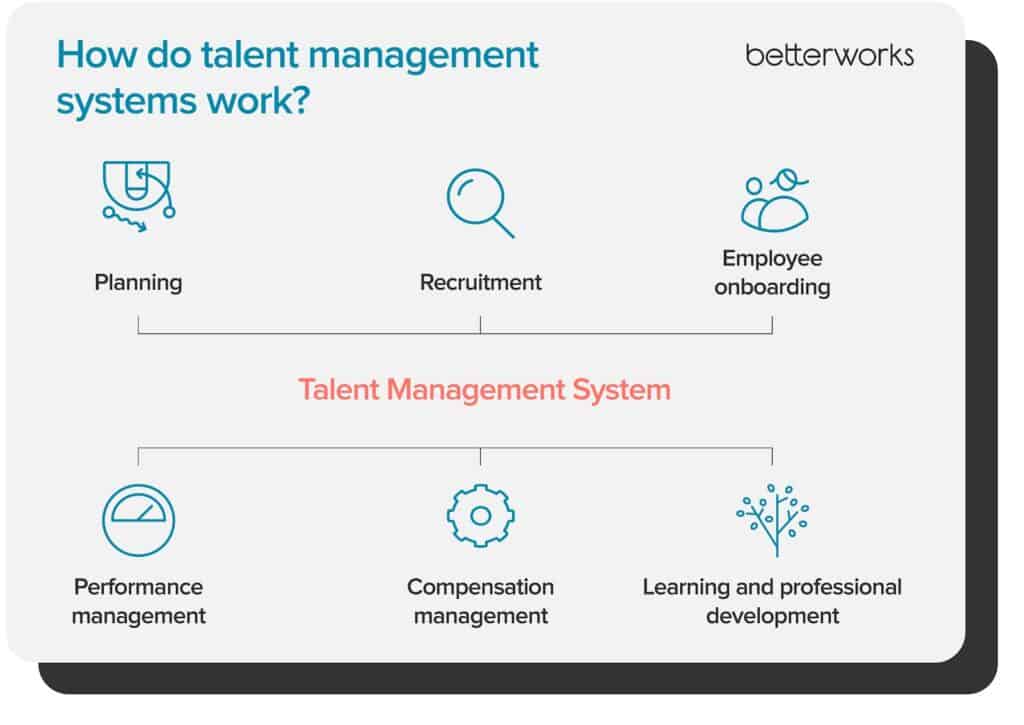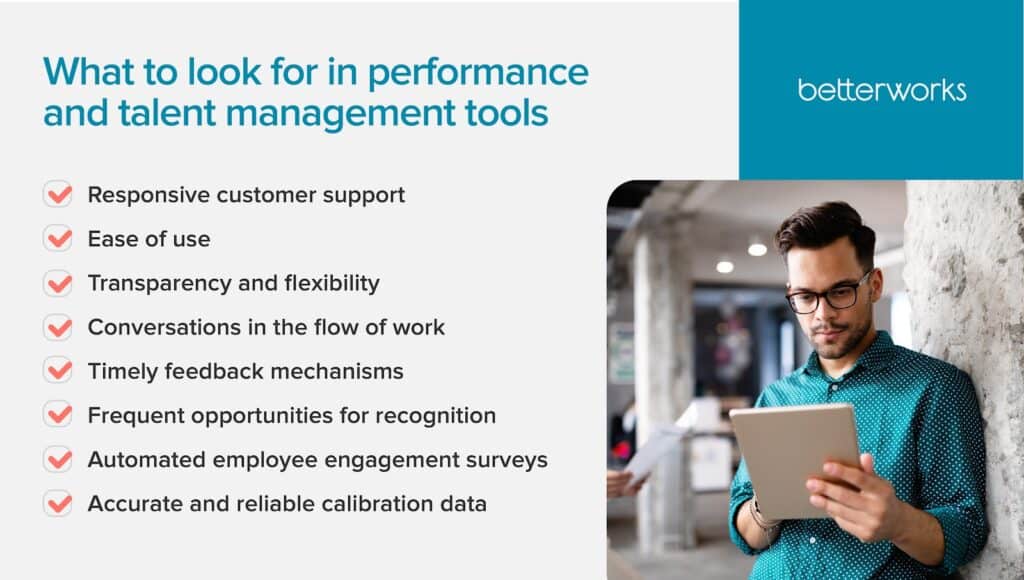Talent management is a complex process. You’re dealing with compensation management, employee development, employee retention, and succession planning — and that’s just scratching the surface of a comprehensive talent management strategy. You need a structured talent management system to organize all of these components.
Enterprise human resources processes can become cluttered over time. Asking managers and employees to add new processes to what they’re already doing can decrease buy-in and dilute the impact of each initiative.
That’s where a talent management system can help. A comprehensive talent management system is more than a collection of transactional software tools. Your talent management system connects those tools across HR functions, namely recruitment, performance management, learning and development, and compensation management. When backed with an effective strategy, you can use your talent management system to transform your workforce processes and drive business results.
A talent management system can help you identify which processes create the most value, produce the most relevant data, and improve business outcomes so you can focus your HR team’s efforts. Let’s learn how you can use your talent management system to add structure to complex and vital workforce processes.
What is talent management?
Large organizations depend on reliable processes to sustain themselves. Yet people management is often disjointed or siloed across roles and functions. That produces inconsistent results and prevents your HR team from pulling together valuable data to support better decision making.
Talent management is a blanket term for strategic management of your people and their skills, talents, and abilities to drive your business forward. It touches every HR process, including workforce planning, recruitment, performance management, and professional development.
Why use a talent management system?
The people who work inside enterprise organizations generate millions of data points. Keeping tabs on this HR data can be overwhelming without support from a talent management system. With all your people data accessible in one place, you can better manage talent and make future-facing talent decisions for your business.
By pulling the tools you use across HR functions together into one unified database, your talent management system unites various processes into a comprehensive dataset.
Many talent management software tools streamline workforce processes by introducing automation across HR functions. These automations can include pre-programmed performance management processes, learning prompts to spark development conversations with employees, or assessments triggered at a certain point in the hiring process. Talent management automation reduces the administrative burden on your HR team so you can focus on bringing your talent strategy to life.
How do they work?

Talent management systems pull together HR functions from across the business and have a focus on the employee. In practice, different HR functions have access to different modules, but the data they input during daily use feeds into a comprehensive employee data set housed in the wider talent management system.
Recruiters, for example, use your talent management system’s recruitment function to collect applications, review candidates, and decide who to move down the hiring funnel. At the same time, recruiters are inputting data regarding each candidate’s skills, abilities, and aptitude. That data contributes to a comprehensive picture of your workforce. Learning and development professionals pull that same data into their module for mapping skills, identifying gaps, and planning learning activities to fill those gaps.
Your talent management platform’s configurable dashboard allows you to visualize the workforce based on your organizational chart, skills, engagement, and other factors. Having readily accessible data to support strategic decisions empowers your HR team to make smarter workforce decisions that drive business results.
What to look for in performance and talent management tools

Selecting a talent management platform is a multifaceted process. You’ll need a system that your HR team, managers, and employees will actually use — and that supports your ideal HR processes.
A variety of tools are on the market, and the technology is always changing, but some factors are constant. Look for these common elements when choosing a talent management solution for your organization.
Responsive customer support
Implementing a new software program is already challenging — and the more people who use that software, the more challenging the implementation process becomes. When selecting the right tool for your talent management needs, confirm that your vendor offers implementation support and training services to minimize friction and maintain productivity during the change.
Ideally, your vendor will also offer ongoing content that can help you optimize your system over time. HR tech vendors regularly update their products. Top-tier vendors accompany these changes with interactive content (such as live demonstrations) and one-on-one support to help all users adjust.
Identify talent management system vendors with a positive track record of good customer service.
Ease of use
If your talent management system isn’t easy to use, fewer people will bother. Consider who needs to be able to access and operate your system, how regularly they’ll use it, and what factors might make it easier for them to adopt the system in the flow of their work.
Your HR team will use your talent management system frequently. Recruiters want to identify and move the right candidates down the hiring funnel. Strategic HR leaders want to identify skills gaps during workforce planning exercises. Payroll professionals want to manage compensation and benefits.
Managers make up another important user base. Managers are most likely to use talent management software for administering onboarding, managing performance and compensation, and mapping learning paths. They need talent management systems that are easy to use. Managers are more likely to use talent management software that they can access through tools they’re already using regularly. Look for software that integrates with the systems managers already use (like Microsoft Teams or Google Workspace) to make it more accessible.
Employees, meanwhile, will use talent management software to track and manage their goals, interact with colleagues, and identify opportunities for growth. The system you select must have a simple and intuitive user interface that they can use without extensive training or experience.
Transparency and flexibility
Setting and aligning employee goals across the organization is an essential function of an effective performance management system, which is a key piece of your talent management system. Look for a performance management system that allows you to record and communicate company priorities transparently across the broader workforce.
Before having their own goal-setting conversations, managers and employees must have a line of sight to the direction business leaders want to take. With that information, employees can set goals that align with where the business wants to go and contribute toward that effort. Your talent management system should make it easy for employees to see their own goals in the context of broader business goals.
Employees should be able to see goals for their peers, too. Visibility into goals across their team can help employees see what their colleagues are working on and the roles they and their team play in bringing about the broader business goals.
Employees need flexibility in setting their goals. If an employee needs to move a goal to the following quarter, for instance, or increase the challenge level of a current goal, they should be able to do so in conversation with their managers. Design your talent management system to accommodate this level of flexibility in your performance management process.
Conversations in the flow of work
The performance management function of your talent management system should facilitate better conversations between employees and managers, especially in the flow of work.
Managers across the organization will use talent management software most frequently for performance management. Software won’t be enough, of course. To maintain high performance and keep employees on track to achieve their goals, managers need to check in frequently with their team members.
Identify the best ways for managers to incorporate performance conversations during their daily processes, and look for a talent management solution that fits within that ideal process. Find a talent management software that allows you to include prompts that encourage managers to track performance data.
Timely feedback mechanisms
Employees need access to regular feedback from managers — and vice versa. Look for talent management tools that facilitate 360-feedback across the workforce. Give employees the option to both request feedback on their own work and to provide feedback to their managers and peers.
Performance feedback is most effective when it happens in real time, supporting continued accomplishments and growth. Program your performance management system to prompt managers to leave feedback when employees are working on a new project or taking on more responsibility, for example. Pre-programmed prompts can also help managers build the habit of frequent feedback in the flow of work, which produces better strategic alignment and stronger performance outcomes.
Frequent opportunities for recognition
Delivering much-deserved recognition to your hard-working team members can help them stay engaged and invested. Receiving acknowledgment from managers or organizational leaders can go a long way toward improving employee morale and retention. But don’t overlook the importance of peer recognition. Acknowledgment from peers can be extremely meaningful and gratifying for employees because co-workers often work together day in and day out.
Look for a talent management system that helps peers, managers, and leaders in the organization communicate praise and recognition to individuals. Some software products, like Betterworks’ performance management and engagement solutions, provide opportunities for commenting on accomplishments and recognizing achievements.
A talent management system is key to building employee recognition into your daily processes. More than a third (34%) of managers responding to our 2022 State of Performance Enablement survey cited feedback and recognition technology as instrumental in helping them become better managers. With a tool like Betterworks, you can implement daily feedback and recognition that pushes employees toward peak performance.
Automated employee engagement surveys
An effective talent management strategy depends on having an engaged workforce. As you consider the right talent management system for your business, look for features that gather anonymous employee feedback, including customizable surveys. Find a system that employees trust with their feedback. Make sure that employees know that their feedback will be collected anonymously, aggregated, and viewed cumulatively.
To make viewing collected data more enriching, look for a system with configurable visualizations to interpret employee survey data. With intelligent analytics you can easily turn raw data into specific action items. Share these recommendations with managers and company leaders to develop a strategy for increasing employee engagement and building trust with employees by letting them know you’re listening and taking action.
Accurate and reliable calibration data
The trickiest part for your HR team will be managing all of the data your HR technology stack produces, but a great talent management system makes that process easier, especially for the performance management system.
Traditionally, managers have only generated performance data once per year, during the annual review process. Find a talent management system that empowers daily conversations and feedback so that managers can generate performance data regularly and consistently. The more frequently you input performance data, the more accurate and insightful the conclusions you draw from it will be.
Some talent management tools even automate the calibration process in the performance management platform by aggregating the data collected over time into reports you can understand at a glance. Frequent, automated calibration helps you guarantee that the data you’re collecting remains objective.
Using accurate and reliable data to inform your decisions can minimize bias. That’s key to streamlining workforce processes while fostering a workplace culture that is fair and equitable.
Invest in a talent management system you can trust
HR is a strategic function, and serving the business requires comprehensive talent management — something you can’t afford to leave to chance. Investing in a talent management system can help you streamline your processes and make better, more strategic workforce decisions.
As you consider your options for talent management software, keep your workforce in mind, especially the system’s primary and most regular users. Identify solutions that put the workforce first, and solve the problems users have with existing HR processes.
Learn how integrated talent management solutions connect your talent marketplace.







